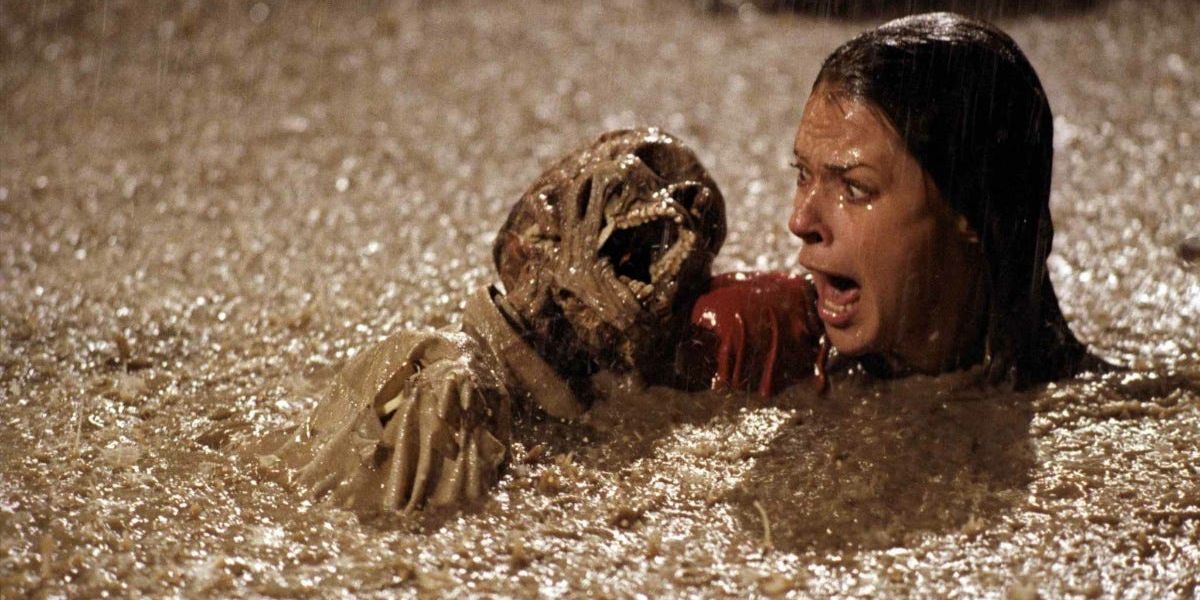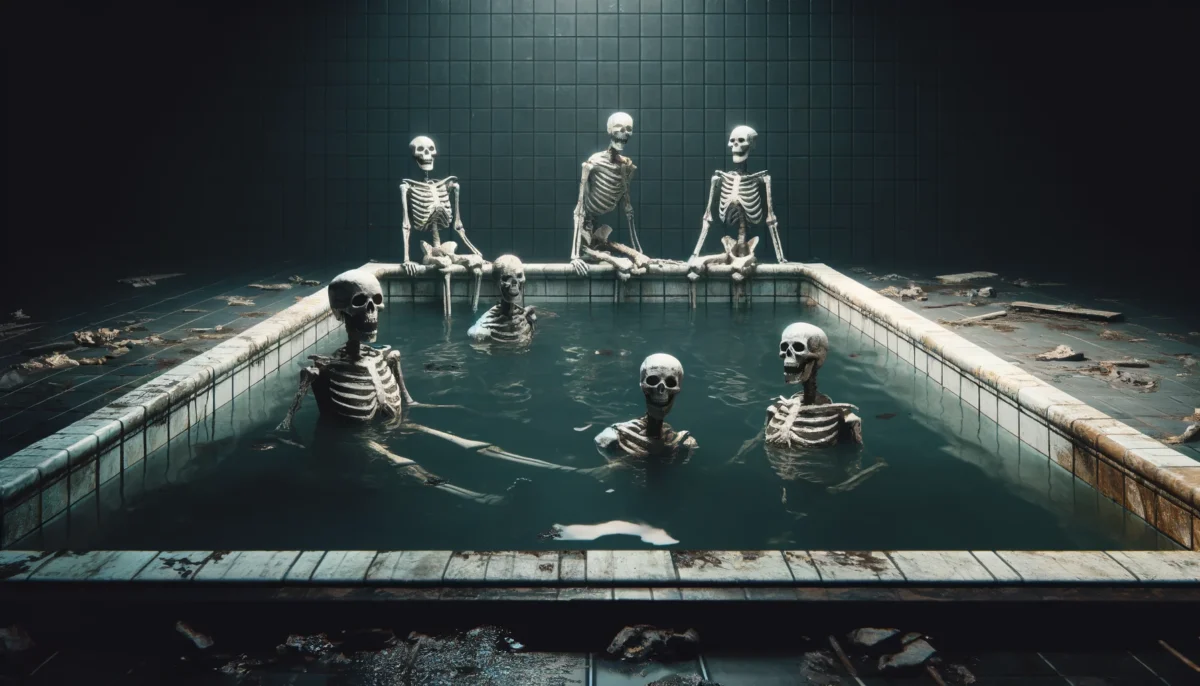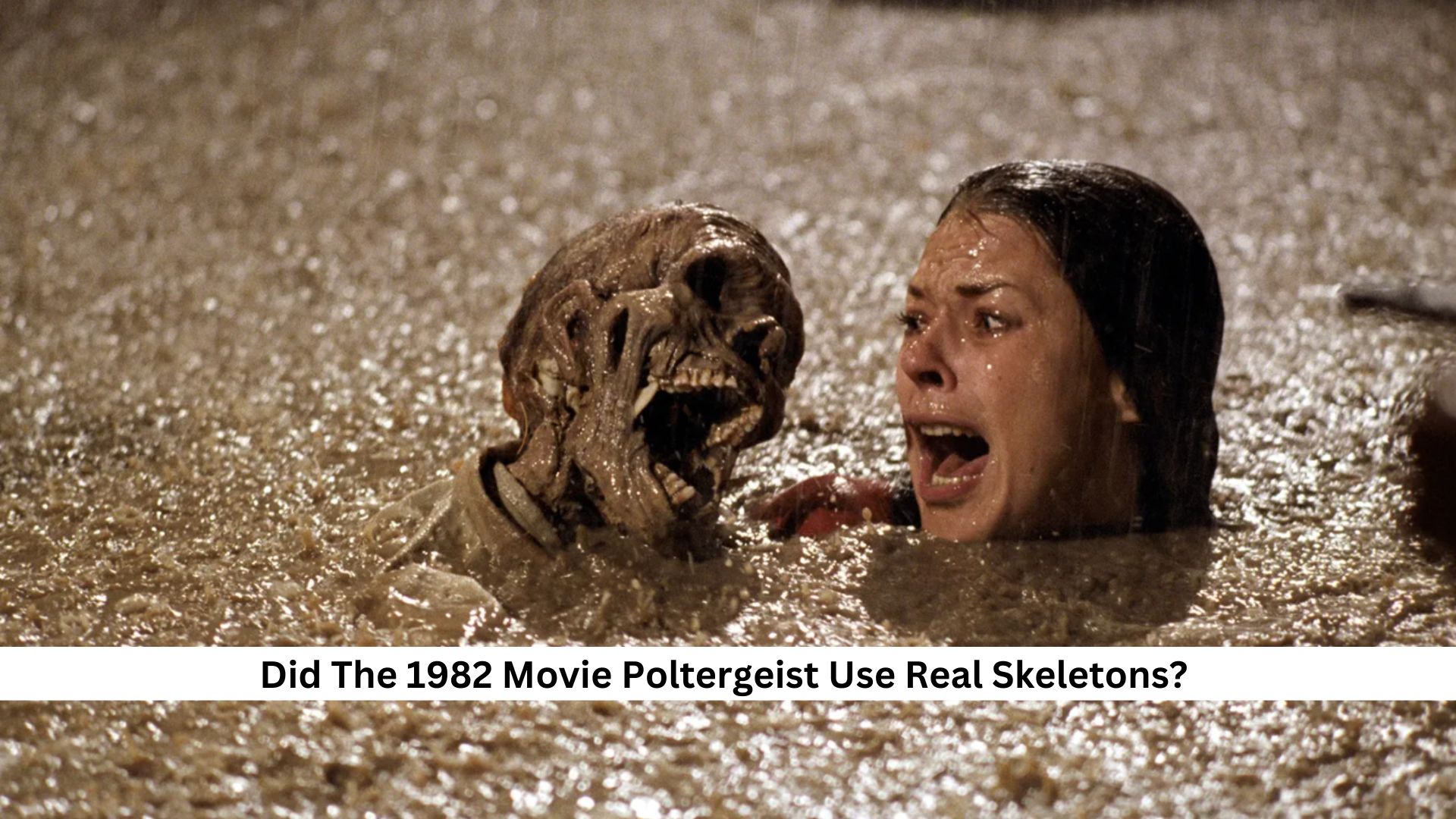The Use of Real Skeletons in the 1982 Film Poltergeist
It’s a well-known fact now that the 1982 horror film Poltergeist utilized real human skeletons in some of its most unsettling scenes. This revelation comes directly from members of the film’s production team, who admitted that real skeletons were chosen because they were more cost-effective compared to synthetic alternatives. The most notable use of these real skeletons occurs in the film’s climactic pool scene, where JoBeth Williams’ character encounters a frightening array of emerging skeletons amidst a torrential downpour. This unsettling detail has continued to intrigue and disturb fans and critics alike, adding a grim layer of authenticity to the film’s ghostly story.
Reasons Behind the Use of Real Skeletons in Poltergeist
The decision to use real skeletons in Poltergeist was primarily influenced by budgetary constraints. During the early 1980s, high-quality artificial skeletons were not only expensive but also difficult to obtain. In contrast, real human skeletons could be acquired at a lower cost from medical supply companies. While these skeletons were not perfectly pristine and often resembled archaeological artifacts, their inclusion provided a level of visceral realism that was challenging to achieve with the special effects technology of the time. This choice, while practical for the film’s production, ignited discussions about the ethical considerations of using human remains in the entertainment industry.
Overview of the Film’s Plot
To fully appreciate the context of this macabre detail, it’s essential to revisit the plot of Poltergeist. The film follows the Freeling family, who relocate to a seemingly perfect suburban home. Their peaceful life is soon disrupted by malevolent spirits that invade their space. As supernatural events escalate—chairs stacking themselves, toys coming to life, and their young daughter Carol Anne communicating with unseen forces through the television static—the Freelings turn to paranormal experts for help. The blend of ordinary life with supernatural terror makes Poltergeist a memorable and chilling entry in the horror genre.
Revealing the Truth: Real Skeletons in Poltergeist
Uncovering the truth behind the 1982 film Poltergeist exposes a chilling reality that goes beyond its cinematic scares. The film, renowned for its eerie special effects and supernatural narrative, controversially included real human skeletons in its production. This unsettling fact not only adds a grim layer to the film’s legacy but also prompts significant ethical debates regarding the use of human remains in entertainment. Examining this contentious aspect of Poltergeist sheds light on the darker facets of Hollywood history and raises important questions about respecting the deceased while creating compelling media.
Spielberg’s Controversial Decision and the Crew’s Reaction
Steven Spielberg’s Poltergeist is celebrated as a landmark in the horror genre, captivating audiences with its intense storyline and pioneering special effects. However, a startling revelation about the film’s production emerged: Spielberg opted to use real human skeletons for certain scenes. This choice, driven by a desire for heightened realism, took both the audience and the film crew by surprise.
Spielberg, known for his meticulous attention to detail, believed that using real skeletons would enhance the authenticity of the film’s supernatural elements. The crew’s reaction was one of surprise and discomfort, leading to discussions about the ethical implications of using human remains. This decision highlighted the tension between artistic vision and ethical responsibility within the film industry, raising awareness about the moral considerations of such choices.
The Legacy of Poltergeist (1982)
Overview of the Film
Poltergeist revolves around the Freeling family, who find their suburban home plagued by malevolent spirits. The plot intensifies when their youngest daughter, Carol Anne, is taken by these supernatural entities. Directed by Tobe Hooper and produced by Steven Spielberg, the film is acclaimed for its suspenseful narrative and groundbreaking special effects.
Influence on the Horror Genre
Poltergeist made a significant impact on the horror genre, merging classic haunted house elements with modern cinematic techniques. Its success not only led to several sequels but also inspired a multitude of other horror films, cementing its place as a seminal work in the genre.
Behind the Scenes: The Real Skeletons in Poltergeist
In a disquieting revelation about the 1982 horror film Poltergeist, it has come to light that real human skeletons were used during production. An actress involved in the film recalled a particularly unsettling experience: “I had to immerse myself in a large tank filled with what I believed to be mud and plastic skeletons. It was later revealed that the skeletons were real, which made the ordeal far more horrifying.” This unsettling discovery has cast a shadow over the film’s legacy and raised significant ethical concerns.
Ethical Implications and Industry Standards
The use of real skeletons in Poltergeist presents profound ethical dilemmas regarding the boundaries of artistic expression and the moral responsibilities of filmmakers. Central to this discussion is the respect due to the deceased, whose remains were utilized without explicit consent. At the time, the legal and ethical standards governing such practices were less defined compared to today’s comprehensive guidelines. Modern industry standards now emphasize treating human remains with dignity and respect, reflecting a broader societal movement towards more ethical practices in entertainment. The controversy surrounding Poltergeist highlights the evolution of industry norms and underscores the importance of ethical considerations in creative decisions.
Reactions from the Cast and Crew
It has been reported that the cast and crew, including JoBeth Williams, were unaware that real skeletons were being used during the filming process. The revelation came as a shock, leading to varied reactions ranging from mild discomfort to intense fear. This information came to light only after the film’s completion, adding an unexpected layer of distress to the production experience.
Public Response
The public reaction to the use of real skeletons in Poltergeist was mixed. Some found the inclusion of authentic remains intriguing, believing it added to the film’s eerie atmosphere. However, others were deeply concerned about the ethical implications of using human remains for entertainment purposes. This reaction underscores the ongoing debate about the moral boundaries of incorporating real human elements in film and media.
Cultural Impact of Using Real Skeletons
The decision to use real skeletons in Poltergeist has had a significant impact on both the horror film industry and its audience. This controversial choice has sparked debate within the horror community about the extreme measures some filmmakers may take to achieve a desired effect. Additionally, the media has played a role in keeping the story alive through documentaries, articles, and interviews, which continue to draw interest and generate new questions from the public.
The Legacy of Poltergeist: Myth or Curse?
The film Poltergeist has been surrounded by rumors of a curse, attributed to the unexpected deaths of several cast members. Over time, these incidents have only heightened interest in the film, reinforcing its mysterious legacy. Whether or not there is a genuine curse, the stories surrounding the film have contributed to its enduring popularity and ongoing discussions among fans.
The Lasting Influence of Poltergeist
The mythos associated with the Poltergeist franchise often overshadows the film’s own merits. The stories that have emerged around the film, combined with its memorable and unsettling scenes, have left a lasting impression on viewers long after the original trilogy. Directed by Tobe Hooper and produced by Steven Spielberg, Poltergeist has secured its place in the horror genre through its innovative approach and iconic moments.
Innovations in Filmmaking: The Production of Poltergeist
Poltergeist revolutionized the use of practical effects in cinema when it was released in 1982. Under the direction of Tobe Hooper and the production oversight of Steven Spielberg, the film utilized groundbreaking techniques, including sophisticated puppetry and inventive camera work. These methods were employed to convincingly portray the supernatural elements of the story, blurring the lines between reality and the eerie occurrences depicted on screen.
Behind the Scenes of Poltergeist
The decision to use real human skeletons in the 1982 film Poltergeist was driven by practical considerations. At the time, obtaining authentic skeletons from medical supply companies was more cost-effective than creating realistic fake ones. Although this practice was not unusual in Hollywood, it was not widely known to the public.
When JoBeth Williams discovered that the skeletons used in her scenes were real, she was understandably taken aback. Despite her discomfort, she continued with the filming, making this behind-the-scenes fact one of the most discussed aspects of the movie.
The “Poltergeist Curse”: Fact or Fiction?
The use of real skeletons in Poltergeist has fueled rumors of a curse, allegedly linked to the disrespectful handling of human remains. After the film’s release, several tragic events, including the premature deaths of young actress Heather O’Rourke and co-star Dominique Dunne, intensified speculation about a supernatural curse. While these incidents are more likely coincidences, they have contributed to a complex mythos surrounding the film that continues to captivate popular imagination.
Behind the Decision to Use Real Skeletons
Practical Effects in the 1980s
In the 1980s, practical effects were crucial to creating convincing horror films. Realistic props, such as authentic skeletons, added a level of credibility that plastic replicas could not match.
Cost Considerations
Surprisingly, using real skeletons was more economical than high-quality plastic models. Skeletons sourced from medical supply companies were not only less expensive but also provided a more lifelike appearance on screen, making them a popular choice in the industry.
Ethical Considerations
Respect for the Deceased
The use of real human remains in film raises important ethical questions. Respect for the deceased and their families is paramount, and many argue that employing skeletons for entertainment purposes constitutes exploitation.
Industry Standards
This controversy led to significant changes in industry practices. Today, stricter regulations and ethical guidelines are in place to prevent the use of human remains in filmmaking, ensuring that respect and dignity are upheld.
Myth vs. Reality: Unveiling the Truth Behind Poltergeist
Confirmations and Denials
The debate over whether real skeletons were used in the 1982 film Poltergeist is marked by conflicting statements. While some individuals involved in the production have confirmed the use of genuine human remains, others have either denied or minimized their involvement. This mixture of affirmations and rejections has only deepened the mystery and speculation surrounding the film.
Evidence Presented
Support for the claim that real skeletons were used comes from photographic evidence and accounts from special effects artists. These sources have solidified the controversy as a notable element of the film’s history.
The Curse of Poltergeist: Fact or Fiction?
Mysterious Deaths
The so-called “Poltergeist curse” refers to a series of tragic deaths among the cast members, which has led some to speculate that the film is cursed. These unfortunate events have intensified the film’s eerie reputation and contributed to its legend.
Persistent Superstitions
Beliefs about the curse endure, with some fans linking it to the use of real skeletons in the film. Whether or not one subscribes to the idea of a curse, it undeniably adds a fascinating layer to the film’s legacy.
Conclusion
The controversy over the use of real skeletons in Poltergeist represents a significant episode in filmmaking history, reflecting the tension between technological innovation, artistic ambition, and ethical considerations. This chapter of the film’s production highlights the evolving nature of ethical standards in the entertainment industry and continues to provoke debate over the limits of artistic expression. As the industry evolves, Poltergeist stands as both a cautionary tale and a point of reflection, reminding filmmakers of the need to balance authenticity with respect and integrity in the pursuit of cinematic excellence.





1 Comment
Pingback: Sanaa Chappelle Three Children: What You Need To Know » Bloghives